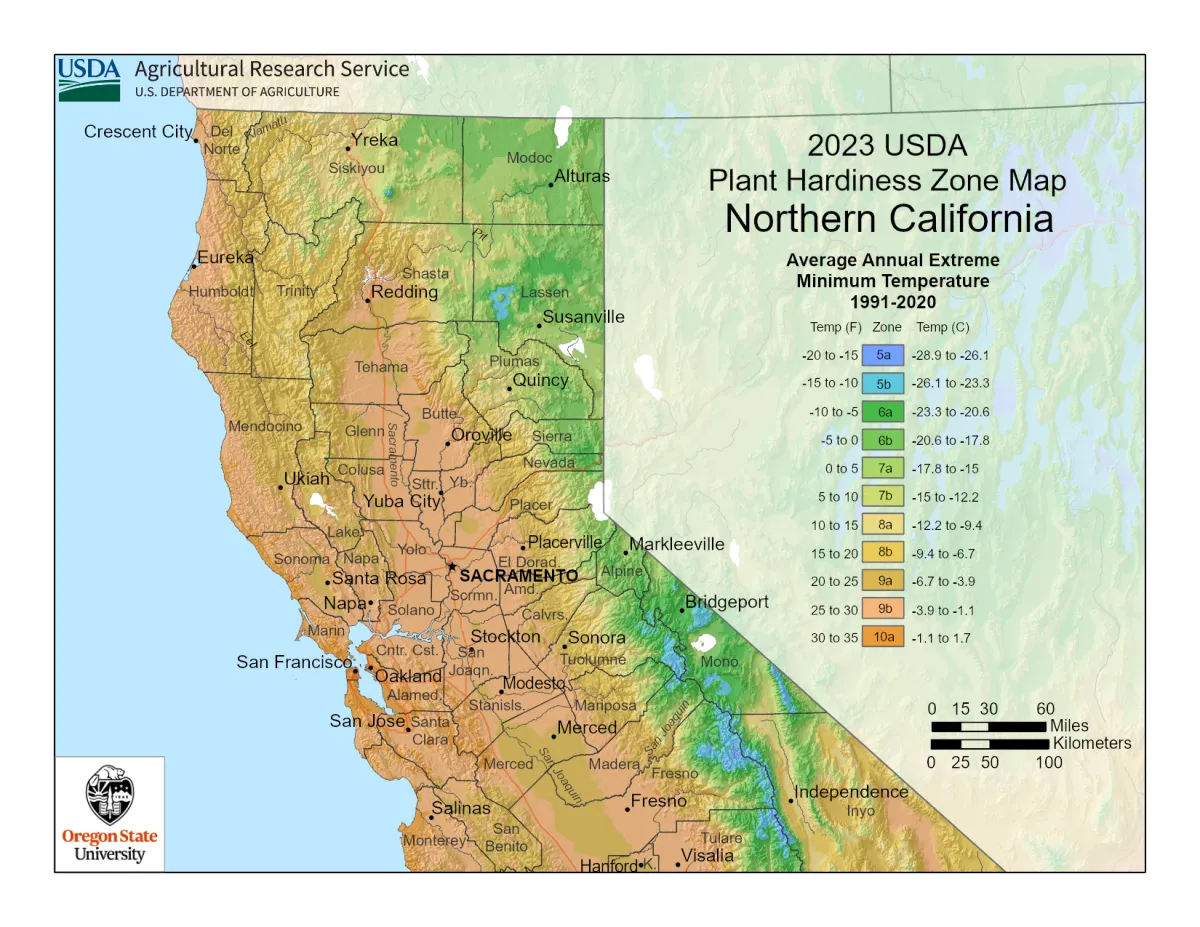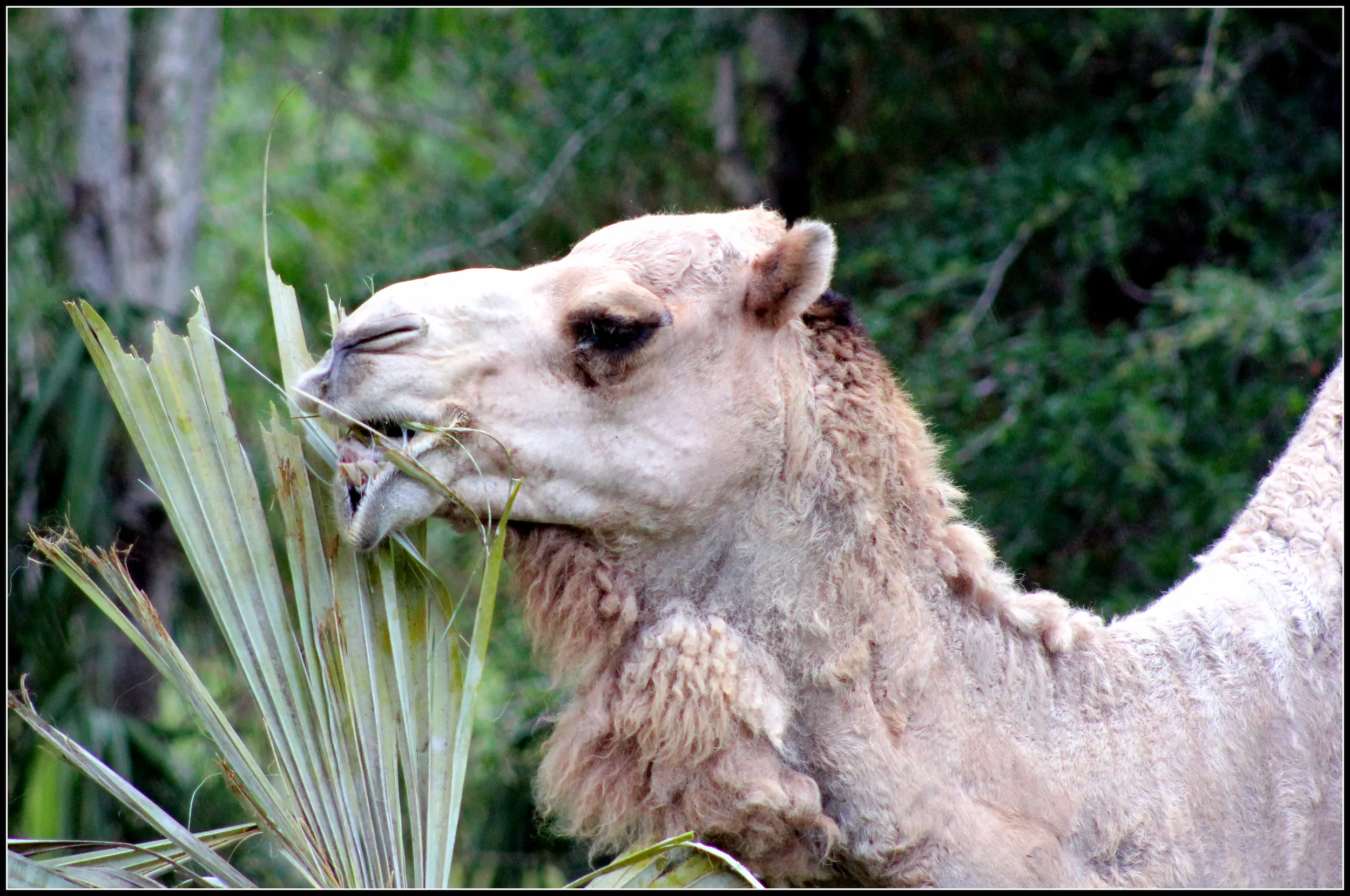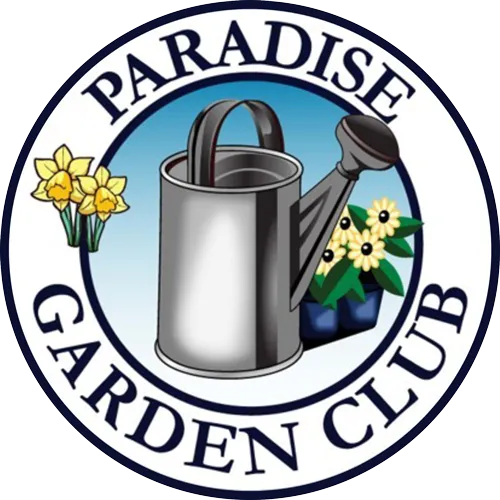2025 Paradise Garden Tour (June 7th & 8th) - Buy Tickets Now!
Planting Zones and Microclimates
in Paradise
In a nutshell:
USDA Hardiness Zone
The USDA Hardiness Zone for most of Paradise is 9b (reaching 25-30°F most winters). (Read more about this.)
AHS Heat Zone
The AHS Heat Zone for most of Paradise is 7, 8 (getting above 86°F about 90 days every year). (Read more about this.)
Sunset Climate Zone
The Sunset Climate Zone in Paradise is 7, but we border a Zone 1A area that starts just a little farther up the hill. (Read more about this.)
... and don't forget the crazy influence of microclimates!
Planting Zones
Probably the widest-known system of comparing plant climate areas is the U.S. Department of Agriculture's Hardiness Zone system. This system averages historical information to predict the lowest likely winter temperature. In this system, zones with higher numbers have milder winters than do zones with lower numbers.
That said, the USDA Hardiness Zone in Paradise is primarily 9b, which means that on average we get down to 25-30°F in winter. Use this as a guideline, though, because Paradise is the kind of place where your ears can pop as you drive from one end of town to the other: our elevation ranges from 1500 to 2300 feet. What grows at the lower edge of town will not necessarily grow in upper Magalia (Zone 9a, averaging winter lows of 20-25°F).

Microclimates
A microclimate is defined as a local atmospheric zone where the climate differs from the surrounding area. Within a microclimate things may be warmer, cooler, wetter, drier, more or less prone to frosts even than areas quite nearby. Often one microclimate will combine many of these attributes. A microclimate may be tiny, such as a vegetable garden (or even just a corner of it). Alternatively, a microclimate could take up many square miles, such as a valley, a canyon floor, or an exposed hilltop.
Does Paradise have microclimates? You bet!
For one thing almost the entire area south of Pearson is known as a local “Banana Belt.” The mild winters, warm summers, and great sun exposure here permit homeowners to grow a wonderful variety of plants almost year-round.
In addition, if your property is near either edge of the Ridge, with a canyon view (or close to it), you'll find strong breezes coming your way every morning and late afternoon.
Even within larger microclimates, though, gardeners create tiny, controlled microclimates every time they adjust soil Ph, watering depth, watering frequency, or shade levels (to mention only a few practices) in the yard or garden. (For even more ideas, come to a PGCI meeting and ask about your specific gardening challenge!)
Learn more about microclimates here: https://ucanr.edu/sites/bcmg/Blog/index.cfm?blogpost=55846&blogasset=58737

Camel Smile. Photo by "cuatrok77" (see Credits)
The AHS Heat Zone system
The American Horticultural Society (AHS) Heat Zone system averages historical data to find out how many days of the year a place has temperatures above 86°F (30°C). The AHS identifies this as the point at which plants begin to experience heat damage (camels notwithstanding). As more and more plant suppliers code heat tolerance for their products you may see more plant labels on which a heat designation follows the USDA Hardiness Zone de1 Columnsignation.
The AHS Heat Zone in Paradise is between 7 and 8. Sources offering average temperatures for locales by zip code indicate that average temperatures in Paradise exceed 86°F from about mid June through mid September, or roughly 90 days a year.
For comparison, Magalia is between Heat Zones 6 and 7. Again, though, the watchword is "microclimates."
You can learn more about the AHS Heat Zone system here.
The Sunset Climate Zone system
The Sunset Climate Zone system, from Sunset (purveyors of Sunset Magazine), is a new favorite among gardeners because it accounts for the length of growing season (latitude and elevation), the frequency and amount of precipitation, air movement, humidity, topology---plus the same winter lows as the USDA Hardiness Zone system, the same summer highs as the AHS Heat Zone system. Zones with higher numbers are milder than zones with lower numbers.

In the Sunset Climate Zone system Paradise is in Zone 7 but borders a Zone 1A area, which starts a little higher uphill. (Magalia is closer to the border with Zone 1A.) Sunset calls this "California’s Gray Pine Belt," although gray pines actually are fairly rare in Paradise itself.
You can get more detail on the Sunset Climate Zone system around Northern California here, and general information about the system here.
Microclimates
Microclimates are “local atmospheric zones where the climate differs from the surrounding area” (Wikipedia). Within a microclimate things may be warmer, cooler, wetter, drier, more or less prone to frosts even than areas quite nearby. Often one microclimate will combine many of these attributes. A microclimate may be tiny, such as a vegetable garden (or even just a corner of it). Alternatively, a microclimate could take up many square miles, such as a valley, a canyon floor, or an exposed hilltop.
You can find a very clear explanation of microclimates here on the "Plant California" website.
Does Paradise have microclimates? You bet!
For one thing almost the entire area south of Pearson is known as a local “Banana Belt.” The mild winters, warm summers, and great sun exposure here permit homeowners to grow a wonderful variety of plants almost year round.
In addition, if your property is near either edge of the Ridge, with a canyon view (or close to it), you'll find strong breezes coming your way every morning and late afternoon.
Even within larger microclimates, though, gardeners create tiny, controlled microclimates every time they adjust soil Ph, watering depth, watering frequency, or shade levels (to mention only a few practices) in the yard or garden. Here are some additional ideas. (For even more ideas, come to a PGCI meeting and ask about your specific gardening challenge!)
Manage the temperature
A protected courtyard next to a building is warmer than an exposed field, but it can be made even warmer by a) using a south-facing wall b) managing the amount of shade over the area, and c) maximizing the area's ability to absorb solar energy, by placing dark rocks or bricks around the planting or by using dark-colored mulch. (Remember that many plants will need additional water in the resulting warmer conditions.)
Incidentally, one attractive way to ward off frost in garden citrus trees is to use holiday lights. This approach has proven effective even in temperatures down to the 'teens. Landscape lighting, such as up-lighting under the tree, also has been proven effective. (Avoid LEDs; while they're less expensive to run they give off too little heat. Use "regular" incandescent lighting.) Leave lights on all night: the coldest temperatures of night are just before dawn.
Alternatively, you can cool things down a little by permitting more shade to grow overhead, or by opening the area to more air flow (such as by opening or taking down a courtyard wall).
Manage the wind
Air movement dries plants out, and they replace lost moisture by wicking it up from the ground through their roots. (This is why winter winds can be particularly hard on evergreens, as they can't replace moisture lost through their needles or leaves when the ground is frozen.)
Forceful winds also can often work simple mechanical damage on fragile plants. To build wind protection into a planting, locate it in a protected corner next to a building, or build an architectural wind-break, such as a fence.
Manage the light
You can increase light exposure somewhat by planting near light-colored walls. In planning such areas, make sure that light reflected from bright surfaces is unobstructed, so that it's actually available to your plants.
You might also concider using light-colored mulch (such as light gray or white gravel) around plants. Keep in mind, though, that sunlight that bounces back results in cooler soil.
For seedlings, consider artificial light in the form of a light table or light box. Many excellent plans are available online.
Again, for more ideas on creating small but useful microclimates, come to a PGCI meeting and ask around! You'll find people willing to answer your questions.
Be Part of a Movement That’s Restoring and Beautifying Our Town!
Join the Paradise Garden Club today and help us cultivate a thriving, resilient community.
Join Our Newsletter
Contact Info
P.O. Box 1246, Paradise CA 95967
© 2025 Paradise Garden Club. All rights reserved. Site by Revision Road
